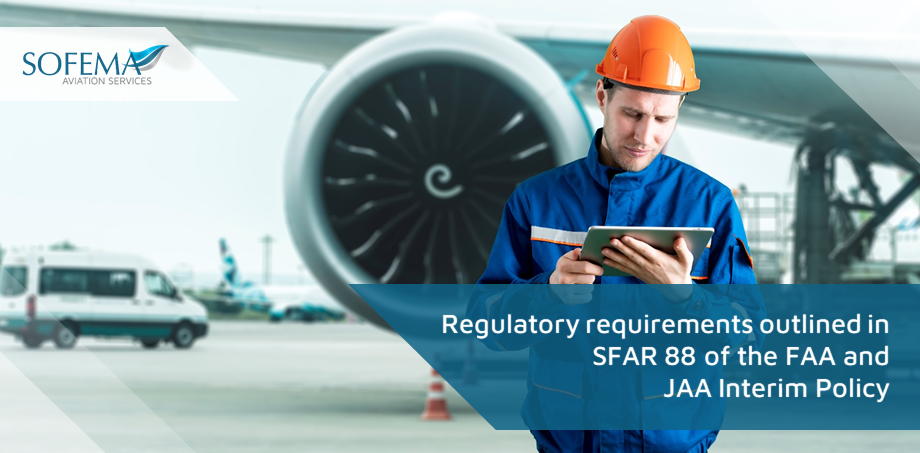Sofema Aviation Services (SAS) (www.sassofia.com) considers the regulatory requirements outlined in SFAR 88 of the FAA and JAA Interim Policy. These requirements focus on ignition prevention program initiatives and goals, such as identifying and correcting unsafe conditions and systematically improving fuel tank maintenance, as detailed in the JAA Temporary Guidance Leaflet (TGL) 47.
Introduction
The regulatory frameworks and guidance provided in SFAR 88 of the FAA and JAA Interim Policy INT POL 25/12 and TGL 47 enhanced aircraft fuel tank safety by focusing on ignition prevention, identifying and correcting unsafe conditions, and improving maintenance practices.
These measures were designed to ensure that aircraft fuel tanks remain safe and minimise the risk of fuel tank explosions through proactive and continuous safety initiatives.
Aircraft fuel tank safety became a critical aspect of aviation safety, driven by regulatory considerations and various initiatives to prevent ignition and ensure systematic improvements in fuel tank maintenance.
- Several key regulatory frameworks and policies have been established to address these concerns, including the FAA’s Special Federal Aviation Regulation (SFAR) 88, the Joint Aviation Authorities (JAA) Interim Policy INT POL 25/12, and the JAA Temporary Guidance Leaflet (TGL) 47.
Regulatory Considerations – SFAR 88 (FAA)
SFAR 88, issued by the Federal Aviation Administration (FAA) in 2001, was a significant regulatory step towards enhancing fuel tank safety. This regulation was a response to the TWA Flight 800 disaster in 1996, which highlighted the need for better protection against fuel tank explosions. SFAR 88 mandated the following:
Ignition Prevention Program Initiatives and Goals:
- SFAR 88 required aircraft manufacturers and operators to develop ignition prevention programs.
– These programs focused on identifying potential ignition sources within fuel tanks and implementing measures to mitigate these risks. The goal was to eliminate ignition sources, thus preventing explosions.
- Identification and Correction of Unsafe Conditions: The regulation called for a comprehensive review of existing aircraft designs to identify unsafe conditions related to fuel tank safety.
– This included evaluating wiring, electrical components, and other potential ignition sources within and around fuel tanks.
– Once identified, unsafe conditions must be corrected through design changes, retrofits, or enhanced maintenance procedures.
Systematic Improvement in Fuel Tank Maintenance: SFAR 88 emphasized the importance of systematic improvements in fuel tank maintenance.
– This involved developing detailed inspection and maintenance protocols to ensure that potential ignition sources were regularly checked and mitigated.
JAA Interim Policy INT POL 25/12
The Joint Aviation Authorities (JAA) issued Interim Policy INT POL 25/12 as a temporary measure to address fuel tank safety until more permanent regulations could be established. The policy aligned closely with the principles of SFAR 88 and included similar initiatives and goals:
- Ignition Prevention Program Initiatives: Like SFAR 88, the JAA’s interim policy required the implementation of ignition prevention programs. These programs aimed to identify and mitigate ignition risks within fuel tanks through design reviews and enhancements.
- Identification and Correction of Unsafe Conditions: The policy mandated that aircraft manufacturers and operators conduct thorough evaluations of fuel tank systems to identify unsafe conditions. Corrective actions were required to address any identified risks, ensuring the continued safety of fuel tank operations.
- Systematic Improvement in Fuel Tank Maintenance: The JAA policy stressed the need for continuous improvement in fuel tank maintenance practices.
- This included developing and implementing rigorous inspection schedules and maintenance procedures to prevent ignition sources from compromising fuel tank safety.
JAA Temporary Guidance Leaflet TGL 47
Temporary Guidance Leaflet (TGL) 47, issued by the JAA, provided detailed guidance on fuel tank safety regulations compliance. TGL 47 served as an instructional document to help aircraft manufacturers and operators meet the requirements set forth by SFAR 88 and INT POL 25/12. Key aspects of TGL 47 included:
- Detailed Inspection Guidelines: TGL 47 provided specific instructions on inspecting fuel tank systems for potential ignition sources. This included guidance on inspecting electrical components, wiring, and other elements that could pose a risk.
- Maintenance Procedures: The leaflet outlined best practices for maintaining fuel tank safety. This included recommended intervals for inspections, methods for addressing identified issues, and procedures for ensuring that maintenance actions were properly documented and followed.
- Compliance Strategies: TGL 47 offered strategies for achieving compliance with SFAR 88 and INT POL 25/12. This included recommendations for retrofitting existing aircraft, incorporating new safety features into designs, and continuously monitoring and improving fuel tank safety measures.
Next Steps
Sofema Aviation Services and Sofema Online provide Classroom, Webinar & Online training Covering Fuel Tank Safety Initial and Recurrent Training Obligations – Please see the websites or email team@sassofia.com
Tags:
Regulatory Requirements, JAA, FAA, SAS blogs, maintenance procedures, SFAR 88, Temporary Guidance Leaflet TGL 47, Interim Policy, Detailed Inspection, Compliance Strategies, Ignition Prevention, Unsafe Conditions




